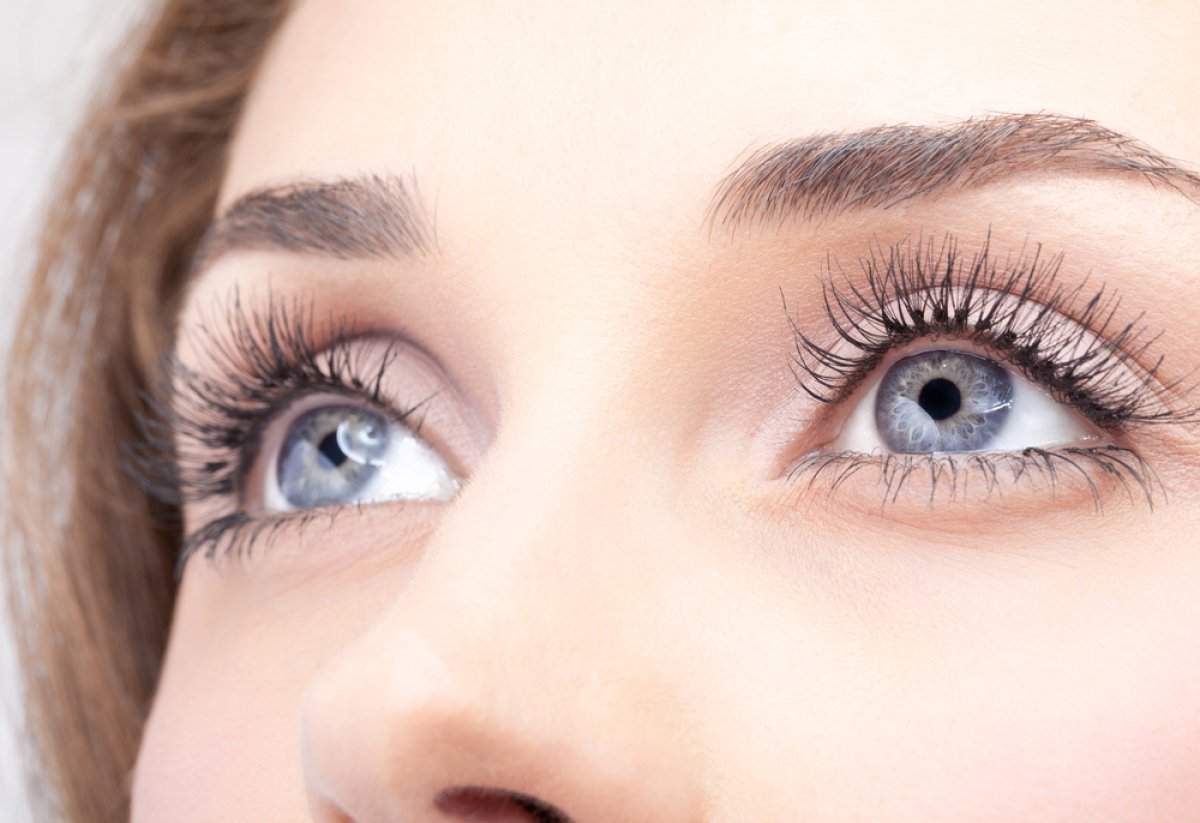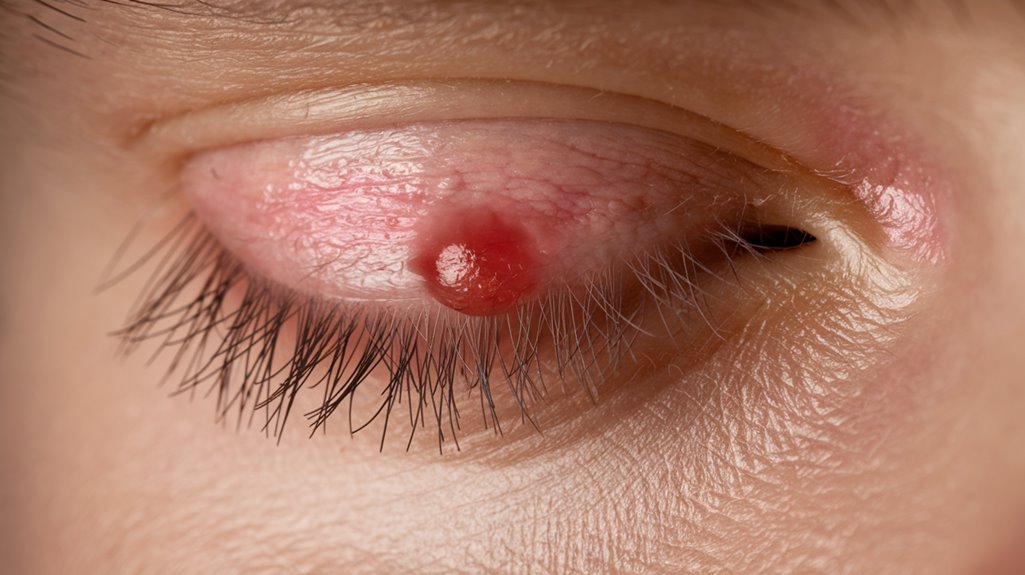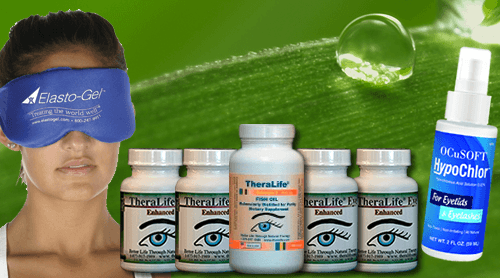TheraLife’s products are designed to address the underlying causes of blurred vision from chalazia, which occur due to mechanical pressure on the eyeball and meibomian gland dysfunction. By promoting the health of the meibomian glands, TheraLife products help restore tear film stability and reduce corneal distortion, thus improving vision clarity. Their comprehensive approach not only targets the chalazion itself but also mitigates symptoms like irritation, watery eyes, and peripheral vision obstruction. By exploring TheraLife’s offerings, you’ll gain insights into effective management strategies for chalazia-induced blurred vision, which can be exacerbated by large chalazia and environmental irritants. TheraLife provides holistic solutions to help customers manage these challenges effectively.
Best Chalazion Treatment from TheraLife
Chalazion caused by clogged meibomian oil glands. Root cause is chronic dry eyes. Try oral dry eye treatment for dry eyes to stop chalazion and prevent recurrence.
Add To CartKey Takeaways
- Chalazion exerts mechanical pressure on the eyeball, distorting the cornea and causing blurred vision.
- Meibomian gland dysfunction disrupts oil production, destabilizing the tear film and contributing to blurred vision.
- Larger chalazia increase localized pressure on the eye, heightening vision disturbances.
- Corneal surface distortion from chalazion pressure can lead to temporary astigmatism and blurred vision.
- Inflammation from chalazia can cause mild irritation and peripheral vision blockage, leading to blurred vision.
Pressure on the Eyeball
When a chalazia forms, it can exert pressure on the eyeball, potentially causing blurred vision due to the mechanical force applied to the eye. This increase in eye pressure results from the accumulation of oil within the blocked meibomian gland, leading to swelling. As the chalazion enlarges, the localized pressure affects not only the immediate area but can impact the entire eyeball. Larger chalazia are more likely to cause significant pressure, resulting in vision disturbances. Symptoms of this pressure include blurred vision, mild irritation, and watery eyes. To alleviate eye pressure, reducing the chalazia’s size through treatments like incision and curettage is often necessary. Consistent warm compress use is an effective first-line treatment to promote drainage and reduce inflammation, potentially alleviating symptoms. Effective management can relieve symptoms and prevent further vision complications. Clogged oil glands surrounding the eyelashes are often the cause of chalazia development, which can be exacerbated by touching the eyes with dirty hands.
Meibomian Gland Dysfunction
Meibomian gland dysfunction (MGD) is a prevalent condition affecting the eyelids and ocular surface, characterized by a disruption in the normal function of the meibomian glands. These glands are responsible for oil production, essential for a stable tear film. Aging can lead to gland deterioration, reducing oil production and causing blockages. Environmental factors, like smoke and pollution, irritate the glands. Hormonal changes, particularly in menopause, alter gland function. Medical conditions such as rosacea or blepharitis cause inflammation, hindering meibum production. Poor eyelid hygiene allows bacterial buildup, leading to blockages. MGD is a common precursor to chalazia, which form when a meibomian gland becomes clogged or blocked. MGD frequently coexists with other conditions, such as allergies, exacerbating symptoms. MGD manifests in various forms: obstructive, hyposecretory, cicatricial, and noncicatricial, each with distinct glandular anomalies impacting oil production, contributing to ocular surface instability.
Common Symptoms
A chalazion often manifests with multiple symptoms that can greatly impact visual clarity and comfort. The chalazia cause vision distortion primarily through direct pressure on the eyeball, altering the corneal shape and resulting in blurred vision. You might also notice peripheral vision blockage and temporary astigmatism due to the distortion of the ocular surface. A decrease in lump size is a sign of healing, which can lead to improved vision as the pressure on the eyeball decreases. Eyelid ptosis, caused by a large chalazion, can further obstruct your vision. Corneal irritation occurs if the chalazion scratches the cornea. It’s important to differentiate chalazia from other eyelid conditions like hordeolum, as treatments may vary significantly.
Here’s a concise breakdown:
- Pressure on Eyeball: Causes corneal distortion and blurred vision.
- Peripheral Vision Blockage: Obstructs side vision pathways.
- Temporary Astigmatism: Alters the eye’s refractive configuration.
- Eyelid Drooping (Ptosis): Hinders visual field due to drooping.
Risk Factors
Identifying the risk factors associated with chalazion formation is essential for prevention and management. Demographic factors play a significant role; females and individuals from non-white races, particularly Black and Hispanic, have higher risks. Adults aged 30-50 are commonly affected, with those in the Northeast experiencing increased diagnosis rates. Systemic conditions also contribute; chronic blepharitis and skin disorders like rosacea impact Meibomian glands, raising chalazion risk. Chalazions form due to the blockage of Meibomian glands, which can be caused by thick oil or debris buildup. In addition, non-ocular inflammatory conditions such as sarcoidosis and Graves’ disease are linked to higher incidences. Environmental and behavioral factors, including air pollution exposure, poor eyelid hygiene, and frequent eye rubbing, additionally exacerbate the risk. Understanding these elements can guide effective prevention strategies and minimize chalazion-related complications. Regular eyelid cleansing is crucial for maintaining good hygiene and preventing the recurrence of chalazion.
Treatment Options
You should initiate early treatment for a chalazion with warm compresses and gentle massage to promote drainage and healing. Regular use of warm compresses can mitigate dry eye symptoms by stabilizing the tear film and reducing infection risks. Most chalazia are painless and often resolve on their own, but intervention may still be necessary if complications arise. If these non-surgical methods are ineffective, advanced options like steroid injections or surgical drainage may be necessary, especially for lesions that impair vision. Timely intervention is essential to prevent complications and guarantee a more straightforward resolution of the condition.
Surgical and Non-Surgical Methods
When dealing with chalazion treatment, it’s essential to take into account both surgical and non-surgical methods given their distinct advantages and indications.
For surgical techniques, incision and curettage effectively removes inflammatory debris, especially for chronic cases. Non-invasive options like warm compresses and lid scrubs promote drainage and hygiene, reducing recurrence risk.
Consider these:
- Incision and Curettage: Ideal for large, non-resolving chalazia, involves local anesthesia and minimal scarring.
- Warm Compresses: First-line, non-invasive therapy that softens chalazia for natural drainage.
- IPL and IRPL Therapy: Non-surgical, light-based treatments that improve meibomian gland function.
- Steroid Injections: Alternative for persistent nodules, reducing inflammation without surgery.
Each approach has specific indications, ensuring personalized care. A chalazion results from a blockage in the meibomian glands, leading to accumulation of oil that can cause inflammation. Large chalazia can cause visual disturbances due to corneal compression, highlighting the importance of timely intervention.
Importance of Early Treatment
Prompt intervention in chalazion treatment is vital to mitigating potential complications and guaranteeing a swift recovery. Early intervention through warm compresses and eyelid massage markedly reduces inflammation and risk of infection. By addressing these symptoms early, you can improve resolution rates, potentially avoiding surgical procedures. Chalazia account for 13.4% of benign eyelid lesions, emphasizing the importance of timely and effective management. The treatment benefits extend to pain management, as prompt care can alleviate discomfort. Additionally, early action aids in protecting vision by preventing blurred vision from large chalazia. Maintaining eye hygiene post-treatment helps in minimizing infection risks and supporting recovery. For patients with recurrent chalazia or underlying conditions like blepharitis, early and more aggressive treatment strategies, including antibiotics for severe inflammation, are essential. Consulting an eye care specialist for persistent cases guarantees thorough care and may include options like steroid injections or minor surgical drainage.
Prevention Strategies
To effectively prevent chalazions and associated blurred vision, adopting rigorous hygiene practices is essential. Ensuring a clean environment around your eyes can greatly reduce bacterial transfer, a key factor in chalazion development. Chalazions often fade on their own within a month, but prevention is still the best approach. Here are evidence-based strategies to help maintain eye hygiene:
- Wash your hands before touching your eyes or handling contact lenses to minimize bacterial exposure.
- Regularly clean your eyelid margins using gentle scrubs or lid hygiene wipes to prevent recurrent chalazions.
- Use hypochlorous spray (HOCL) to safely reduce bacteria and maintain a sterile periocular environment.
- Replace eye makeup products such as mascara and eyeliner every three months to prevent bacterial buildup.
Additionally, warm compresses are a documented non-invasive treatment for chalazions, enhancing local circulation and drainage of blocked meibomian glands.
Best Chalazion Treatment from TheraLife
Chalazion caused by clogged meibomian oil glands. Root cause is chronic dry eyes. Try oral dry eye treatment for dry eyes to stop chalazion and prevent recurrence.
Add To CartManaging Chalazion
Although chalazions can often resolve on their own, managing them effectively requires a structured approach. You’re encouraged to develop chalazion awareness and consider lifestyle adjustments to mitigate their impact. Regular application of warm compresses and eyelid massages can facilitate drainage and reduce inflammation. Consistent cleaning routines and the use of effective eyelid cleansers are vital for maintaining eyelid health. It’s important to note that chalazia are not contagious, which means good hygiene practices can significantly reduce their occurrence. If these measures are insufficient, consult an eye care specialist for potential intralesional steroid injections or, as a last resort, surgical removal.
| Method | Purpose | When to Use |
|---|---|---|
| Warm Compresses | Reduce inflammation | Initial treatment |
| Steroid Injections | Decrease size | If compresses fail |
| Surgical Removal | Excise persistent chalazion | Large or recurrent chalazia |
Adopt these strategies to manage chalazions effectively, enhancing ocular health and reducing vision disturbances. Seek professional evaluation for persistent or recurrent cases, ensuring thorough care.
Best Chalazion Treatment from TheraLife
Chalazion caused by clogged meibomian oil glands. Root cause is chronic dry eyes. Try oral dry eye treatment for dry eyes to stop chalazion and prevent recurrence.
Add To CartFrequently Asked Questions
How Long Does a Chalazion Usually Last?
You’ll find that a chalazion’s duration typically ranges from two to eight weeks.
However, if untreated, it can extend to a few months. Duration symptoms like lump size and severity directly affect recovery time.
Early intervention, such as warm compresses or professional treatment, may shorten healing.
Generally, chalazions resolve within four to six weeks, with signs of recovery including lump size reduction and decreased discomfort, enhancing overall recovery time.
Can a Chalazion Cause Permanent Vision Damage?
Oh, the irony of a seemingly harmless chalazion potentially leading to permanent vision damage! Yes, it can.
Chalazion complications include chronic inflammation, corneal abrasions, and increased intraocular pressure, all contributing to vision impairment.
Larger, untreated chalazia may cause persistent astigmatism and ocular surface damage.
Prompt treatment and surgical intervention can mitigate these risks.
Are There Any Home Remedies for Chalazion?
To address chalazion, you can use natural treatments like warm compresses. Soak a clean cloth in warm water and apply it to the eyelid for 5-10 minutes, repeating 2-3 times daily to soften trapped oils and promote drainage.
Incorporate gentle eyelid massage to enhance effectiveness. Aloe vera and cucumber offer soothing relief, while tea tree oil provides antibacterial benefits.
Always guarantee proper hygiene and consult a professional for persistent cases.
Is Chalazion Contagious?
Rest easy knowing that a chalazion won’t make the rounds like a cold.
It’s a discreet guest, not spread through touch or closeness.
You’ll notice symptoms such as a painless lump, but it doesn’t mean you’ve got something catching.
For treatment, embrace warm compresses to gently encourage the blockage to clear.
If it lingers, consult an eye specialist for precise interventions, ensuring you see clearly without a hitch.
Can Diet Affect Chalazion Development?
You can’t definitively link diet to chalazion development, but nutritional deficiencies and dietary impact are worth considering.
Vitamin A deficiency has been associated with chalazia, indicating a potential preventive role.
Some evidence suggests gut microbiota manipulation through diet might influence chalazion outcomes.
Despite anecdotal claims about reducing dairy or increasing omega-3 intake, no concrete evidence supports these measures, highlighting the need for more thorough, evidence-based studies in this area.
Best Chalazion Treatment from TheraLife
Chalazion caused by clogged meibomian oil glands. Root cause is chronic dry eyes. Try oral dry eye treatment for dry eyes to stop chalazion and prevent recurrence.
Add To CartConclusion
TheraLife’s products offer effective solutions for managing eye conditions like chalazions, which can cause blurred vision by exerting pressure on the eyeball. By addressing the root causes such as meibomian gland dysfunction, TheraLife’s products help reduce recurrence and alleviate discomfort. Their comprehensive approach includes promoting eyelid hygiene and using natural treatments, ensuring clearer vision and healthier eyes. With a significant recurrence rate of chalazions, effective management is crucial. TheraLife’s commitment to understanding risk factors and symptoms allows for proactive steps in treatment, enhancing eye health and comfort for its customers.





